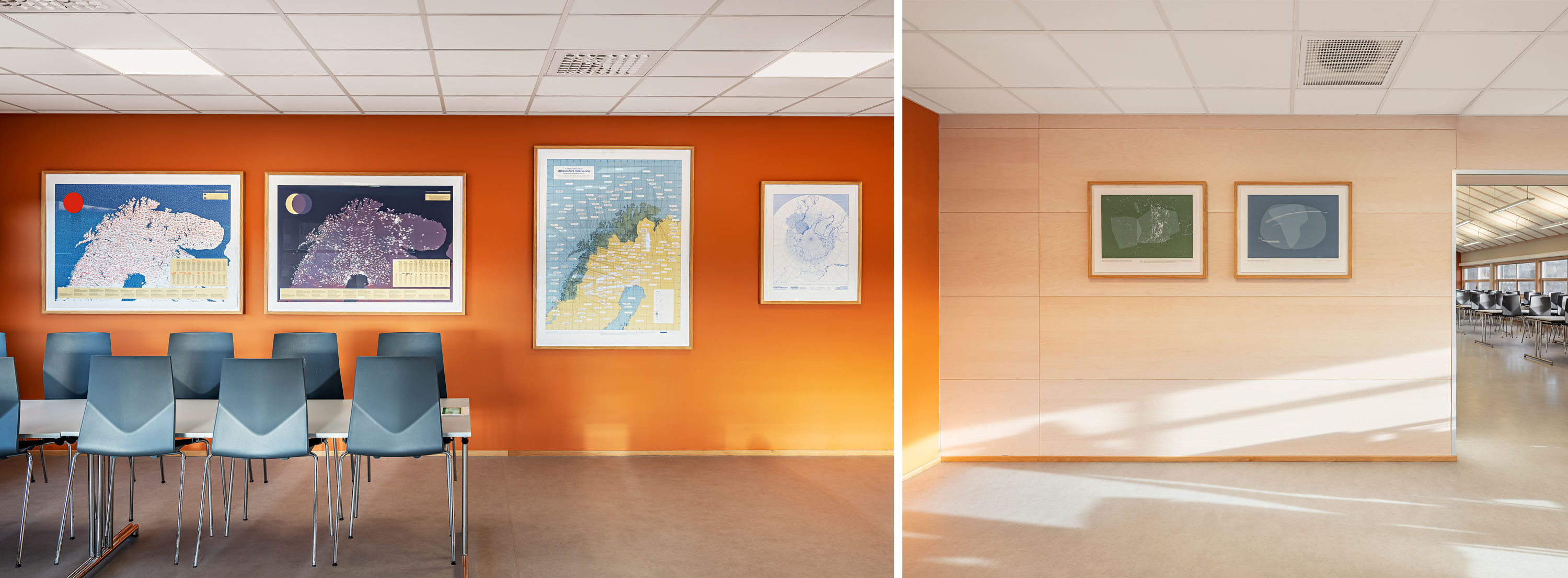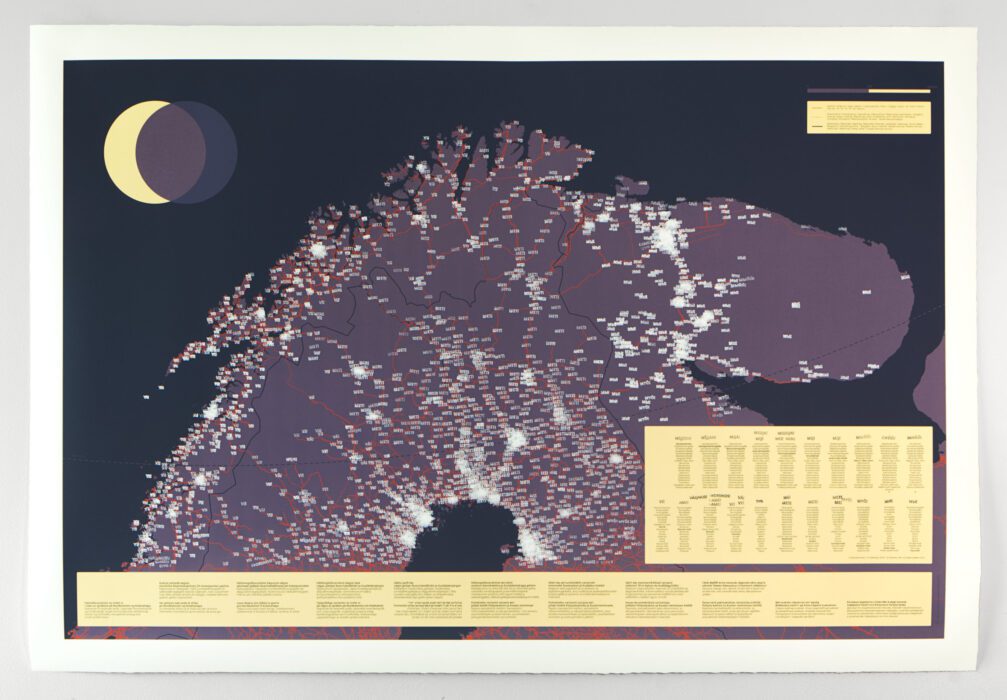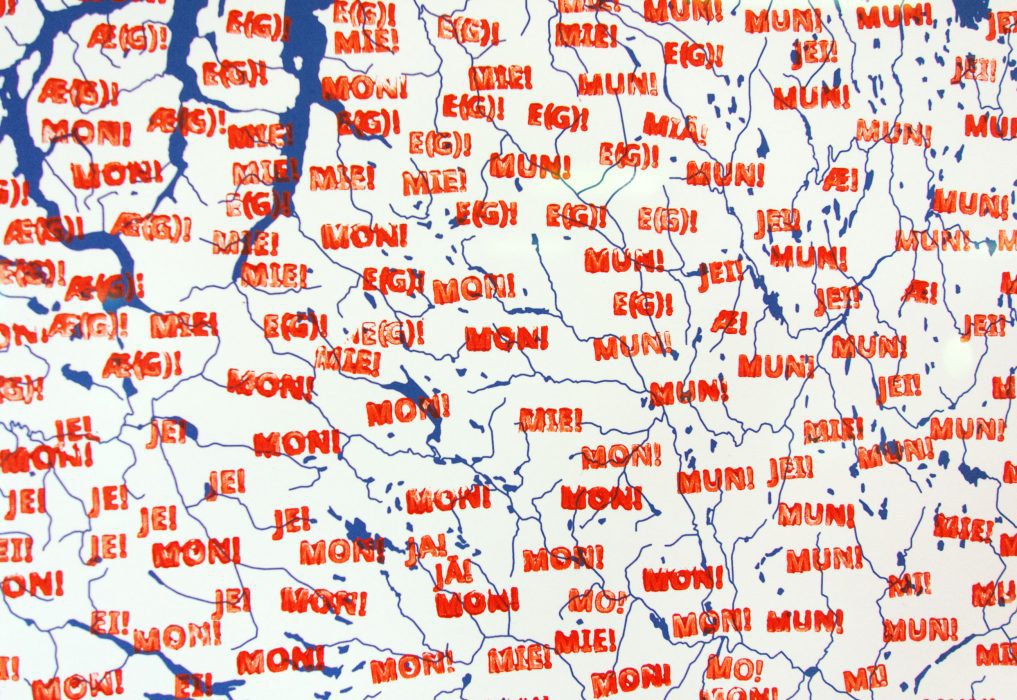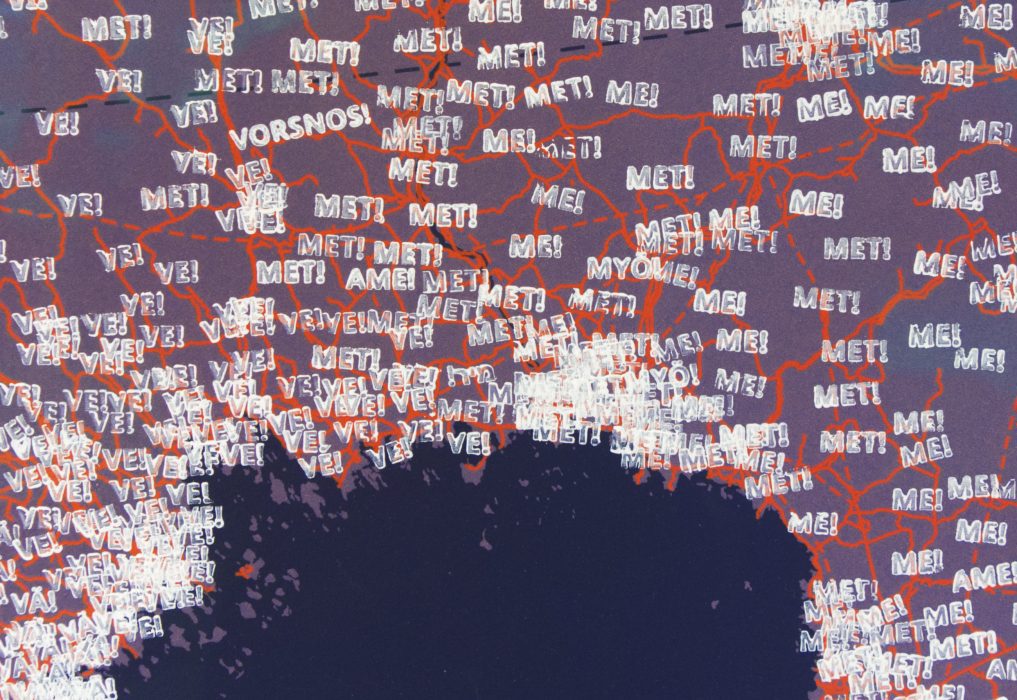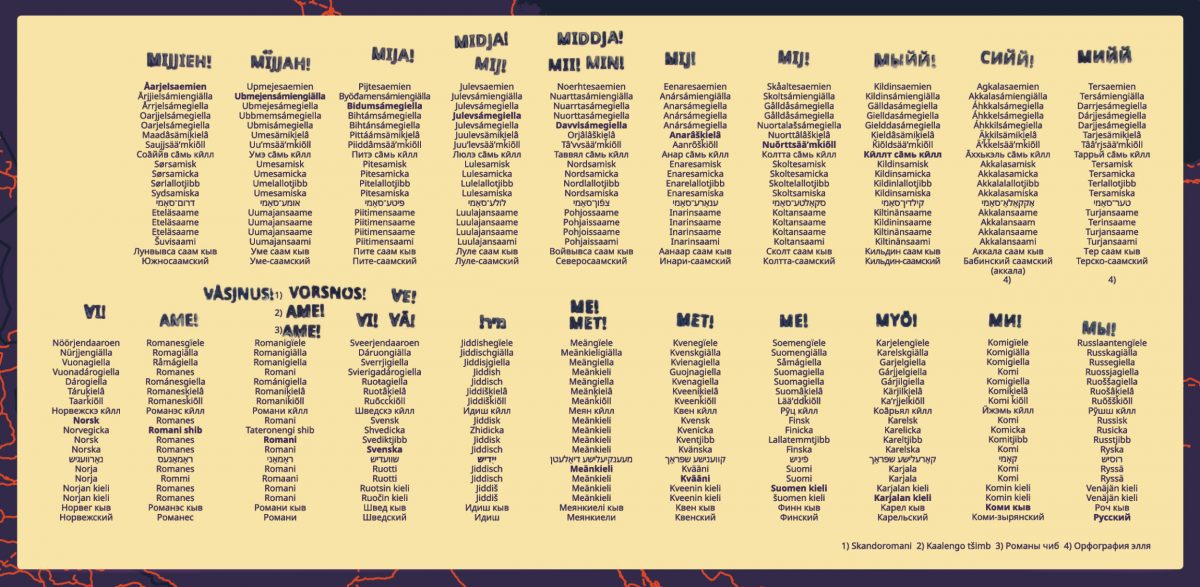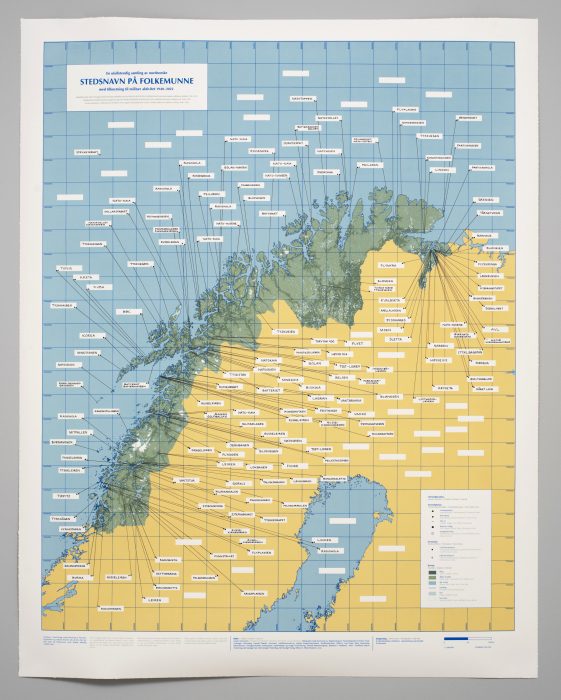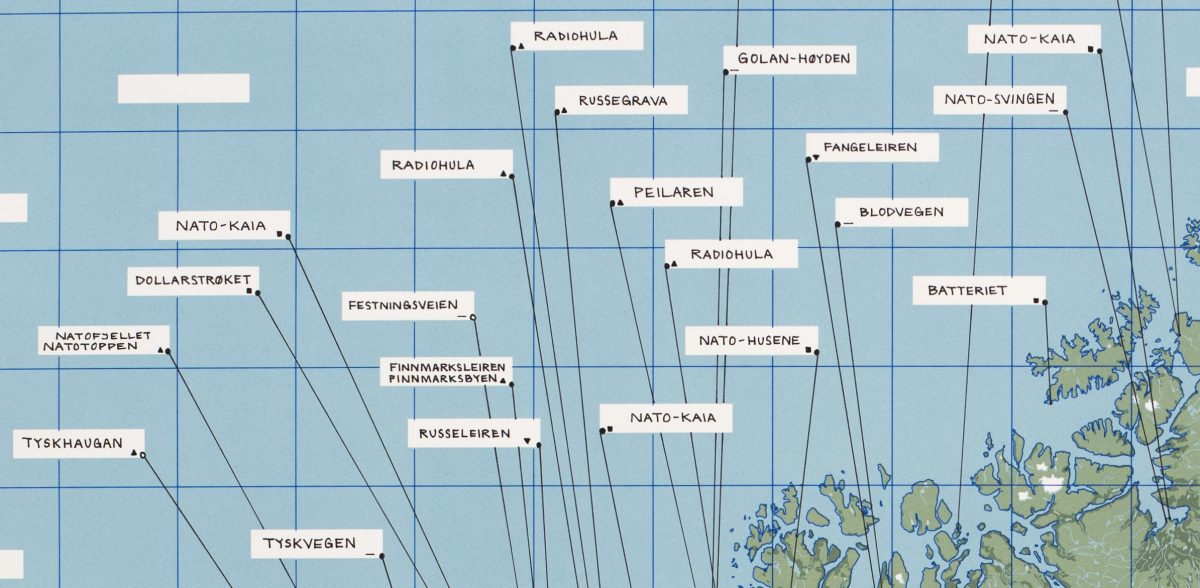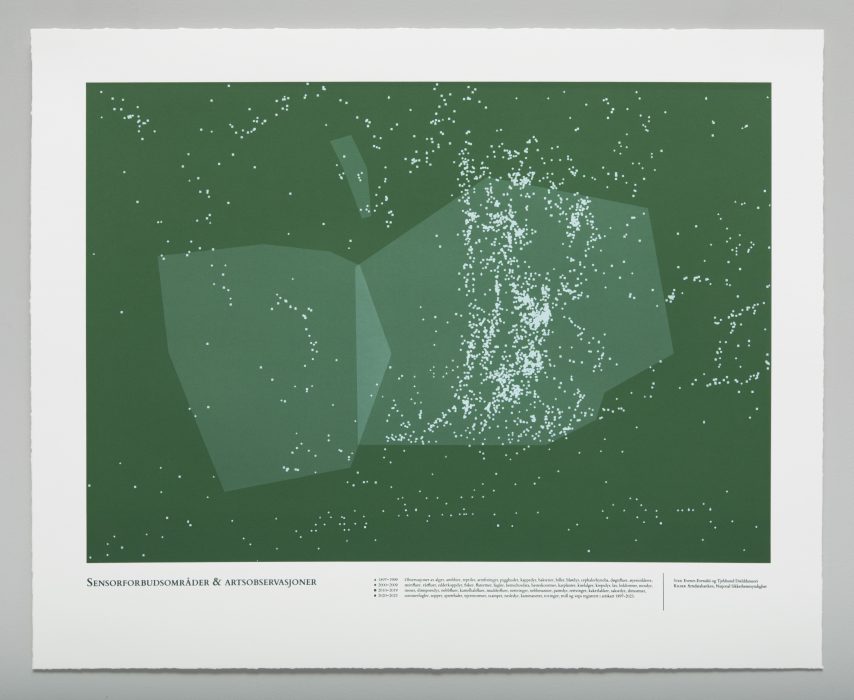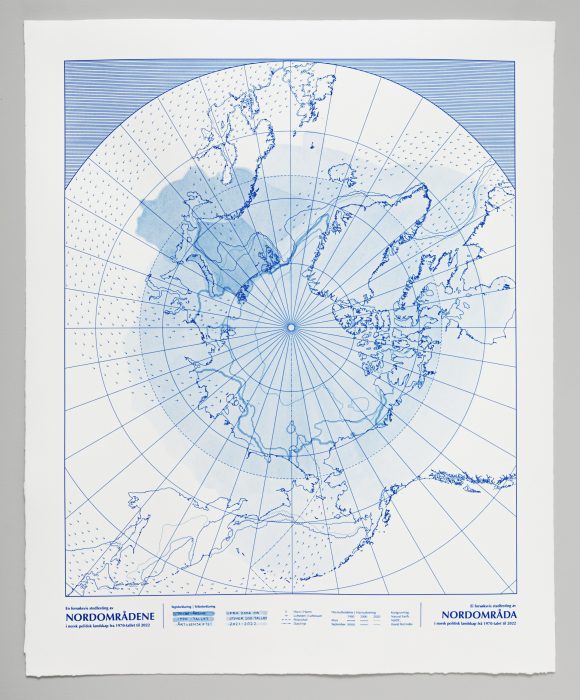Commissioned by KORO (Public Art Norway) for Evenes Air Station
Photo, installation view: Vegard Kleven
The six silkscreen prints in the series Presence are images in the form of maps showing sections of the so-called Norwegian «High North», or «Nordområdene». The High North in the Norwegian context is not a geographically defined place, but a concept in Norwegian foreign policy that deals with international relations in the northern border areas. The map sections in the artworks cover local, regional and circumpolar parts of these areas.
The idea of the series as a whole is to highlight some of the ways in which political conditions and the presence of the Norwegian Armed Forces in Northern Norway are reflected in the language and landscape. Each work in the series has its own theme and method, from personal observations of fleeting traces in the sky, to collecting vernacular place names and mapping linguistic diversity.
Personally, the project is an investigation of the region I come from, as I grew up in Harstad in Northern Norway, and is a reflection on how «politics of the High North» in a broad sense is written into consciousness both as real experiences and interpretations.
The project was commissioned by KORO, Norway´s national agency responsible for art in public space, for Evenes Air Station, Forsvarsbygg, and are installed in the military area.
The work «Locating the High North» is a circumpolar map of the Arctic broadly outlining which geographical areas have been meant by the term «the High North» (Nordområdene) as it has been used in Norwegian politics since the 1970s. Traditionally, the term refers to Norwegian foreign policy concerning European areas north of the Arctic Circle, primarily maritime areas and relations with Russia. From a political perspective, however, it has also been defined geographically – with various delimitations – and has sometimes been used to refer to domestic political conditions. Based on written sources, I have attempted to identify different boundaries for the term in different time periods, and painted these areas with watercolours on the silkscreen print.
The map section in the two images I! and WE! is the Cap of the North, i.e. the northernmost parts of Finland, Norway and Sweden, the Kola Peninsula in Russia, and Sápmi. The two images show ways of saying the words «I» and «we» in 19 of the languages spoken in these areas. Information about the languages and how these particular pronouns are pronounced in dialects has been collected from various sources, and the words are individually hand-stamped on top of the silkscreen print. The pronouns are placed in different patterns in the two images: In I!, the pronouns are placed throughout the terrestrial areas approximately based on where the languages and dialects are and have traditionally been spoken. In WE! the pronouns are placed so that they give a visual impression, but not a statistically correct representation, of today’s population density and language situation.
Colloquial place names linked to military activity is a map of Northern Norway with informal place names that I have collected from local informants and written sources. The place names are associated with the Norwegian Armed Forces, war history and military activity from 1940 to 2022, as they are or have been used locally in the vernacular. The stories behind the place names are typically that they have arisen spontaneously as descriptions of infrastructure and events related to World War II, the Norwegian Armed Forces and NATO, as well as some names that are about associations with other places in war or conflict. The place names and locations are handwritten on top of the silkscreen print.
Sensor prohibition areas & Species observations forms a schematic image of Evenes Air Base and the surrounding area of Evenes and Tjeldsund municipalities. The image consists of two layers of geographical information taken from public sources. The geometric fields in the image are from the Norwegian National Security Authority’s map of areas where photography, filming and the use of other sensors from the air are prohibited. The small dots in the image are from a dataset by the Norwegian Biodiversity Information Centre and show the location of all observations of species – plants, animals, birds, insects, fungi, and others – that have been made at the site and registered in their species map.
Visual field & Human-made clouds is a diagrammatic representation of the outer limit of my own field of vision, combined with a drawn representation of observations I have made of cloud-forming contrails from aeroplanes in the sky over Evenes and Tjeldsund.
Production
Research assistants, place names: Anna Näumann, Tiina Portti, Maud Pold
Research assistant, language: Joni Hyvönen
Text consultant: Audun Lindholm
Assistant, GIS: Axel Bache-Wiig
Printing: Trykkeriet Bergen / Daniel Persson
Framing: TRE Studios / Sam Alyoussef
Sources, colloquial place names:
Local informants and Aftenposten, bodo.kommune.no, DigitaltMuseum, Finnmarksposten, Framtid i Nord, Gratangen historielag, Harstad Tidende, iFinnmark, Lokalhistoriewiki.no, Lofoten Krigsminnemuseum, Nordlandsmuseet, nrk.no, Nye Troms, Rana historielag, Riksantikvaren, Salangen-Nyheter, Saltenposten, Sandnessjøen og omegn turistforening, Sentralt stedsnavnregister, Stadnamn i Nordland – Arkiv i Nordland, Sømna historielag, Sør-Varanger Avis, Sør-Varanger historielag, Sør-Varanger turlag, telltur.no, ut.no.
Translations:
Meri Alarcón og Elina Kangas (Meänkieli), Jo Forbord Stavdal og Yelizaveta Landenberger (Yiddish), Simon Forsmark (Ume Sámi), Marit Breie Henriksen (Northern Sámi), Markus Juutinen (Skolt Sámi), The Karelian Language Revitalization Programme of the University of Eastern Finland (Karelian), Mari Keränen, Kainun institutti – Kvensk institutt (Kven), Lars Theodor Kintel (Lule Sámi), Anja Labj (South Sámi), Alexandra N. Leontieva (Russian), Jukko Mettovaara (Inari Sámi), Lucy Moffatt (English), Niko Partanen (Komi), Oscar Rossi (Finnish and Swedish), Elisabeth Scheller (Kildin Sámi), Rolf Theil (Romani and Romanes), Olve Utne (Pite Sámi), Magnhild Øen Nordahl (Nynorsk). With thanks to: Morten Olsen Haugen, Marit Breie Henriksen, Jørn-Robert Knutsen, Ilkka Liikanen, Minna Muurahainen, Nina Refsnes, Maria Kemi Rein, M. Seppola Simonsen, Peter Steggo, Pekka Suutan, Sari Suvanto, Milla Tynnirinen.
Commissioner: KORO
Curators: Jan Freuchen and Linn Pedersen
Art consultant: Anna Katharina Haukeland
Many thanks to all collaborators and to everyone who has contributed knowledge about history, place names and languages.
-

«I!», screen print with stamped details, (2022), 95x140 cm
-

«WE!», screen print with stamped details, (2022), 95x140 cm
-

Detail from «I!»
-

Detail from «WE!»
-

Detail from «WE!»
-

Detail from «WE!»
-

Detail from «I!»
-

«Colloquial place names linked to military activity», (2022), 140 x 110 cm
-

Detail from «Colloquial place names linked to military activity»
-

«Sensor prohibition areas & Species observations», (2023), 60 x 75 cm
-

«Visual field & Human-made clouds», (2023), 60 x 75 cm
-

«Locating the High North», (2023), 81 x 66 cm
